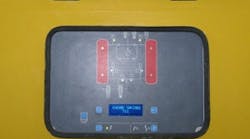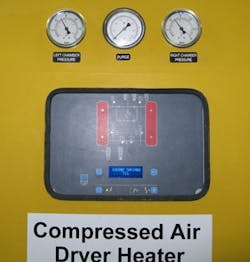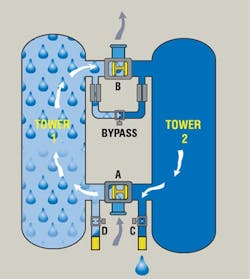[javascriptSnippet]
Pity the neglected air dryer: Much time and attention is paid to efficiently controlling air compressors, but often the control of air dryers gets ignored. If your plant has desiccant dryers, it's important to manage their operation effectively, too, in order to get the maximum return from your compressed-air efficiency efforts.
Consider, as an example, a large desiccant air dryer recently found in a fertilizer plant during a compressed air audit. The specifications for the dryer stated that typical compressed air consumption for cooling air purge should have been 2% of the compressed air flow through the dryer. But when measurements were taken this flow turned out to be ten times higher than expected. In addition, the purge was causing an extra compressor to run during times of peak system demand. The cause of this problem turned out to be both operator error and the way the air dryer was adjusted.
Why do you need desiccant dryers?
Air dryers are needed to remove water vapor from the compressed air produced by the air compressors. The flow of air from the compressors is almost always 100% saturated with water vapor and, in the case of air-cooled compressors, the air is slightly warmer than ambient conditions. If this wet air were released into the plant, the contained water would condense and collect in low spots along the plant piping. This water would rust the inside of iron pipes, pick up any dirt and oil that has collected in the piping, and (if not filtered or dried) deposit a mess inside your compressed-air-powered machinery or on your product.
Refrigerated air dryers can remove the water vapor from the compressed air, resulting in a dew point at system pressure of about 35 to 40 degrees F, which is adequate for most end uses inside a heated plant. But if the pipes are subject to temperatures below this dew point, water will condense or freeze inside the pipes. Therefore, lower dew points of -40 or lower may be required. In addition, industrial processes using compressed air occasionally will require a higher "instrument quality." Some processes may be sensitive to water vapor. For example, say a plant uses compressed air to transport a product that will explode and burn if it comes in contact with free water. In such a situation and with similar vapor-sensitive processes, desiccant-style dryers are needed.
How desiccant dryers work
Figure 1: Basic Heatless Desiccant Dryer Source: Compressed Air Challenge
Central to the operation of desiccant-style dryers are beds of some type of chemical that will remove water vapor from the compressed air by an adsorption process as the compressed air passes through it. The most common desiccant is activated alumina that is in bead form. Because this desiccant can hold only so much water vapor, there needs to be a way to regenerate it once the desiccant becomes saturated.
Desiccant dryers are designed with two possible paths for the compressed air through two identical desiccant beds that are located inside two pressure vessels, or the dryer towers. When one tower is drying the compressed air, the other is in a regeneration cycle. The dryer has controls and a system of valves that will switch towers on a regular basis without interrupting the flow of compressed air.
There are various common ways to regenerate the desiccant:
- “Heatless” dryers – In "heatless" dryers, the desiccant is regenerated by depressurizing the tower and redirecting a flow of already-dried compressed air through the desiccant beads. The word “heatless” is in quotations because to work most effectively, this dryer type needs the natural heat generated in the adsorption process to help with the regeneration process. This type of dryer typically uses a 10-minute regeneration cycle. The flow of compressed air required for operation of this type of dryer is 15% to 20% of the dryer rating.
- Externally heated – This type of dryer uses an externally mounted electric heater that provides hot compressed air for the regeneration process. Because heated air is more effective in driving off the water from the desiccant, a lower flow of purge air is needed – typically about 7.5% of the dryer rating. This type of dryer does not need the heat generated by the adsorption process to work effectively. Heated dryers use a four-hour regeneration cycle. Use of a heater is more efficient that using compressed air for regeneration, so this type of dryer is less energy intensive than heatless.
- Externally heated blower – This type of dryer directs electrically heated air into the desiccant during the regeneration cycle but uses ambient air from an electric blower instead of compressed air. Therefore, no compressed air is required during the regeneration of the desiccant, freeing it up to send to the plant. After the regeneration cycle is complete, the desiccant needs to be cooled. Hot desiccant does not effectively adsorb water vapor, so failure to cool the desiccant would result in a dew point spike. Because the use of moist ambient air for this cooling could contaminate the desiccant, most dryers use a flow of already-dried compressed air to remove the heat. This cooling purge is rated at 2% of the dryer rating, but this actually means a peak flow of about 8% will flow only during the cooling period (averaging 2%). Some new styles of dryers use other, more-efficient methods of cooling, such as closed loop air or water cooling. Where ambient conditions allow radiant cooling, or where dew-point spikes are not a problem, the cooling purge on some makes and models of dryers can be turned off.
- Heat of compression – If the system has only lubricant-free compressors, then the heat of compression produced by the air compressor can be used to regenerate the desiccant. The heat is directed to the air dryer by bypassing the compressor after-cooler or taking air off the first stage of the compressor. The basic types of heat of compression dryers do not produce a constant -40 dew point or lower, but they achieve a dew-point suppression of a certain number of degrees below ambient conditions, which can be acceptable in some cases. Some newer HOC dryers can achieve similar dew points as other desiccant types through the use electric heaters and/or a cooling purge, which decreases the energy efficiency of the dryer.
Why desiccant dryers can be inefficient
The basic driver of energy consumption for desiccant dryers is the cost to regenerate the desiccant. Second to this is the effect that the pressure differential across the dryer and associated required filters has on the air compressors' efficiency.
The key to understanding desiccant dryer efficiency is realizing that the regeneration or cooling purge is typically based on a percentage of the full-load rating of the air dryer, not the percentage of the actual flow of air through the unit. In a basic uncontrolled heatless dryer – say, one rated at 1,000 cfm – the flow of air used for regeneration would be 150 to 200 cfm (15% to 20%), which is equivalent to about 30 to 40 kW of compressor input power. This flow is constant for fixed-cycle dryers regardless of the flow of air exiting the dryer to the plant. If the dryer is loaded to only half its capacity, then the percentage of air consumed by dryer purge rises to 30% to 40% of the actual plant flow. If the dryer is only one-quarter loaded, then it is 60% to 80%. A common condition that compressed air auditors see is a desiccant air dryer associated with a shut-down spare compressor producing no air but with the dryer still consuming its full rated purge flow. Things get even worse if multiple dryers are in this condition.
Heated dryers use lower combined purge and cooling flow than heatless dryers do, but they have an electric heater that in uncontrolled dryers will heat the desiccant for a fixed period of time. The heater will cycle on less often if the desiccant bed is not fully saturated, but typically the cooling purge remains fixed for the remainder of the four-hour cycle in all conditions.
The desiccant within the air dryers must be protected from fouling by separating and filtering out the free water and compressor lubricant that might be part of the inlet air. If the desiccant becomes contaminated, then the dryer will lose its capacity to remove moisture. To protect the dryer, a filter system is installed on the inlet side of the dryer; normally this takes the form of a particulate filter followed by a coalescing style. On the outlet of the dryer, another particulate filter is installed to prevent desiccant dust from contaminating downstream piping. There is usually a significant pressure differential caused by these filters and additional pressure differential across the dryer itself that will cause compressor discharge pressures to rise and which may result in compressors cycling excessively – both conditions that result in extra energy consumption at the compressor. Let’s go back to the heated blower purge dryer that was mentioned at the beginning of the article. This dryer was designed to consume only 2% of the flow of air through it for regeneration, yet it was consuming 10 times that amount. The causes:
- The dryer was oversized and had been purchased anticipating compressor output capacity of 3,000 cfm, but the actual compressor capacity was 1,500 cfm
- The air compressors were running at only a fraction of their capacity; the actual average combined flow was only 750 cfm or 25% or the dryer rating,
- The air dryer cooling purge has a manual adjustment, which is a large ball valve. This type of valve is difficult to adjust accurately. The instruction tag explaining how to adjust the flow had been lost. At some time in the past, the valve was inadvertently adjusted so that the cooling purge flow more than twice as much as required.
- The dryer was running in fixed-cycle mode and had no controls to enable it to turn down its purge flow or its heating cycle duration.
- Unrelated to dryer purge, the air dryer filters' pressure differential was such that it prevented the associated air compressors from loading fully even though the downstream system was experiencing low pressure. A third air compressor with an associated uncontrolled heatless dryer had to be operated to maintain system pressure whenever the heated air dryer went into cooling mode.
[sidebar id="3"]
Figure 2: The control on this dryer reports 71% savings; this reading can be used to track performance.
All of these problems meant the dryer and the compressed air system as a whole was operating with poor energy efficiency.
Making systems with desiccant dryers more efficient
Desiccant dryers can operate more efficiently by applying dew-point controls. Often, dew-point controls are already installed on a dryer, but nobody has thought to use them. These controls, through various methods, turn off the purge flow on the regenerating side once the desiccant has been fully reactivated, saving compressed air that would otherwise be wasted because of dryer partial loading. The switching of the dryer towers is delayed until the control senses when the desiccant has reached the point of saturation (or when a maximum period of time has elapsed in some dryers).
For heatless dryers, the purge flow is reduced in some proportion to the flow of air being processed. For heated dryers, the purge and cooling flow is reduced in some proportion to both the flow of air and the moisture content of the air. This gives extra savings in some circumstances. For example, because compressed air at 80 degrees F contains about half the water vapor as air at the 100-degree rating of an air dryer, the purge requirements are greatly reduced if the inlet temperatures can be lowered.
Some other efficiency measures related to desiccant dryers:
- Switch to refrigerated – Sometimes a plant does not need desiccant-quality compressed air, but continues to use dryers because of past practice.
- Right-size your dryers – A very large dryer can affect system efficiency if not properly controlled. However, care should be taken to ensure that dryers are sized for worst-case conditions; this often requires dryers to be sized larger than the capacity of the connected compressors.
- Calibrate dew-point controls – The dew-point sensors in a controlled dryer can become contaminated or out of calibration, causing malfunction of the control. The reading should be compared with another calibrated independent meter on a regular basis.
- Upgrade and maintain filters – Desiccant dryers can often be purchased with dual inlet filters; if installed in parallel, they can reduce the pressure differential to one-quarter the normal level. Filters will cause excessive pressure differential if not maintained.
- Be vigilant about keeping free water out – Free water must not be allowed to enter the dryers. Small wet receivers or some sort of separator rated for water removal should be installed directly ahead of the dryer.
- Check purge adjustment – The purge flow can become out of adjustment during the life of a dryer. Check this adjustment regularly.
- Maintain purge mufflers – Plugged purge exhaust mufflers restrict the flow and can cause incomplete desiccant regeneration.
- Maintain switching valves – Switching-valve failure causing valve leakage can allow wet air to enter the dryer from the active side. This causes the dryer to consume much more purge than normal and results in incomplete regeneration. On lightly loaded dryers, this condition can go undetected for long periods of time.
- Turn off the cooling purge – Some heated blower dryer makes and models allow turning off the cooling purge under certain conditions where short dew-point spikes will not cause system problems.
- Monitor dryer hours – Some dryer controls report the status of the dryer and the percentage savings. Keeping a log of these numbers and comparing them week to week can show whether something has gone wrong.
Example dryer installation
A plant producing potato products for the fast-food industry chose to purchase a heated blower-style dryer rather than heatless dryer when the plant was originally built. Had it purchased the heatless style, it would have consumed 15% to 20% of all the compressed air produced, all the time, requiring compressors sized to 200 hp matched with a 2,000 cfm desiccant dryer (300 to 400 cfm purge). Because heated blower dryers consume no compressed air for regeneration, this decision allowed for smaller, 150 hp compressors (one being VSD controlled) to be purchased with a smaller 1,500 cfm dryer. The air compressors selected were water-cooled, lubricated-screw style. The water temperature at this location is always below 50 degrees F which produces a nice cool flow of compressed air during all seasons. Rather than purging every four hours, the dew-point controller installed on the dryer delays regeneration, allowing the dryer to purge only every 12 hours, on average, which allows time for the dryer desiccant to cool off on its own by natural radiation. The dryer style selected allows for turning off the cooling purge; therefore, no compressed air is used for dryer cooling. Dual inlet filters were selected to reduce pressure differential, lowering the compressor discharge pressure. An uncontrolled heatless dryer would have consumed the equivalent of about 60kW in purge related electrical costs. The controlled heated blower dryer consumes an average of 6 kW of heater and blower power. The dryer saves an equivalent of $47,000 of electricity (at 10 cents per kWh) annually. At the time of purchase, the incremental cost of installing the more-efficient dryer and filters was $16,400, resulting in a very quick simple payback.
How can you tell if your dryers are operating efficiently?
The answer to this question usually leads to someone having to read and understand the dryer instruction manual. Someone has to determine how your dryer is supposed to work and then take the time to find out if it is actually performing as specified. Some quick visual checks can identify problems with inlet temperatures, desiccant contamination, purge rates, pressure differential and control settings. You may be surprised to learn that some of your dryers don’t need to be operating all the time. But in a large system, more-detailed analysis involving data logging may be required.
Awareness training (such as that provided in Compressed Air Challenge seminars) can go a long way in helping staff understand how dryers should be operating and how much they cost to operate. In addition, having a trained service provider come in and assess your compressed air system for efficiency can help you identify dryer problems and other related system issues.


